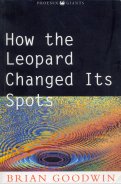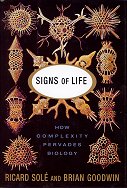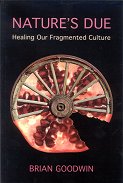This is a fascinating account of the laws of complexity, and how
they are exhibited in various biological systems. We get accounts of
physiology, of the brain, of social insects, of ecological webs, and
of evolution. The book forms a good bridge between coffee table
popularisations and detailed research papers. It includes technical
details, but separated off into boxes, to make them easy to skip if so
inclined. [The boxes are more difficult to read than they need be,
though, using a font unsuitable for mathematics, in black on a dark
grey background.]
We learn that genes aren't everything: that the interaction of the
organism with its environment, self organising to the edge of chaos,
provides a strong framework within which the genes can tinker.
Chaos and order
live together and generate unexpectedly robust patterns of emergent
organization.
The role of genes within this
dynamic context is considerably less than full control and
determination of the developing organism. ... they have the simpler
task of stabilizing generic patterns of emergent complexity in these
multicellular systems.
We learn that dynamics is an important feature of these systems:
brains are not simply passive recognisers, but active systems.
different
learned stimuli were stored as a spatio-temporal pattern of activity,
and the strange attractor characteristic of the attention state was
replaced by a new, much more ordered attractor related to the
recognition process.
Most current
models of neural networks perform remarkably well in a wide range of
areas, but are clearly different from the far-from-equilibrium
behaviour of real neural assemblies.
[these results suggest]
that brain dynamics might involve
multiple attractors and that a coherent and flexible information
processing system requires both order and disorder to operate.
We learn of the importance of social insects.
the dry weight
of ants and termites in some rainforests is about four times that of
all the other land animals
We learn how the environment plays a large role in the observed
complexity of social insects. Indeed, the differences in the
environment alone may be sufficient to explain different behaviours in
different specifies of ants.
[This ant behaviour
simulation is] consistent with
Chris Langton's 1990 conjecture ...
that living systems would maximise their computational capabilities at
the edge of chaos. Computation, in other words, would require some
amount of order, since information must be stored in some stable way.
But the manipulation of information also requires some internal degree
of disorder. The optimal compromise between both requirements occurs
at the transition between order and disorder.
When many small
sources [of food] are present, it is more effective to be able to
switch quickly from an already exploited source to a new one. On the
contrary, if the colony exploits rich but rare sources, it is
important to guarantee that the sources of food are fully exploited at
the cost of a reduced exploratory capacity. That the compromise
between flexibility and efficiency seems to find a place close to
criticality is suggested in particular by the fractal patterns
displayed by [the foraging trails of] some species.
There are some lovely examples of using 3D cellular automata to
model nest building behaviour, again showing how it is the interaction
with the environment can profoundly affect behaviour.
A given spatial
configuration ... triggers the response of a termite worker which
modifies the configuration ... As the configuration changes, so do the
behavioural patterns of the individuals. There is thus constant
feedback between the emerging structure and the spatial distribution
of activity and worker activity.
the same
individual level behaviours my generate different collective responses
in different environments. There is no need to invoke individual
complexity in order to explain the origins of nest complexity. ...
Selective pressures operate on a parameter space where there is a
limited number of possible dynamical patterns and nonlinear rules. As
a consequence, only a limited (but rather diverse) set of higher-level
structures can be obtained.
We learn that examining single species does not tell us enough about
the dynamics of complex ecological systems. Multiple species interact
in non-linear an non-intuitive ways.
understanding
real ecologies requires a scale of organisation far beyond the
single-species level, which is simply uninformative about community
dynamics.
extensive
calculations ... on real food webs show that in many cases adding
predators can increase the number of prey. Indirect pathways very
frequently dominate direct pathways in determining the long-term
outcomes of perturbations.
We learn that adding a spatial dimension to the models has a
dramatic effect on the solutions possible. New solutions become
possible, by allowing waves of interactions to propagate through the
space. This point is made by discussing solutions to non-spatial
equations, where certain parasitic behaviours are non-viable, then
adding a spatial component (usually only two dimensions) and diffusion
or percolation, and showing that viable solutions are now possible.
[Unfortunately, some later arguments are then given for the simpler
non-spatial cases only, leaving me wondering if the results are
meaningful.]
The book could do with better editing. It is somewhat stodgily
written in places, there are typos, and in one chapter many of the
reference numbers are off by one. Despite this, Signs of Life
is well worth the effort of reading. It covers a great range of
biological examples, showing how many kinds of complex behaviours,
non-linear processes, and emergent properties occur. Although the
maths is boxed off to protect the faint hearted, the actual equations
discussed are very simple -- yet displaying that astounding complexity
and subtlety of solution that pervades this whole subject. And the
references to more detailed literature let you follow up specific
cases of interest, should you want to.
Further selected quotes:
a strange
attractor: a region to which trajectories are attracted but within
which they diverge
genotype and
environment do not determine cell state in bacteria. Change of state
can occur spontaneously, without any defined internal or external
cause.
a distinctive
characteristic of networks with K = 2 ... is canalization ...
fourteen of the sixteen [Boolean functions
of two variables] are canalizing
functions. ... For K = 3 ... only 16 of the 256 Boolean
functions of three variables are canalizing, and for K = 4 the
fraction drops below 1%. A useful way of studying the transition from
order to chaos in these networks is to vary the proportion p
of 0's and 1's in the output column of the Boolean functions
[So, can you design a system that self-organises
its value of p to the edge of chaos?]
[studying the brain as a
black box] is rather like trying
to know the details of a movie by watching people leave the theater.
ecosystems
contain many more species than would be necessary if biological
efficiency were the criterion for their organisation.
...
Bak's idea should be generalised for those
systems not displaying a well-defined scale separation between the
driving force ... and the avalanches ... Since the requirement that
the driving force be very slow is a strong one, one is unlikely to
observe power laws in some systems that are nonetheless organised
close to instability points.
increasing
evidence suggests that viruses are often the result of the escape of
fragments of functional genetic programs from their hosts.
the Red Queen
Hypothesis. ... the probability of a species becoming extinct is
approximately independent of its length of existence. ... But if
evolution leads to improvement through adaptation, aren't modern
mammal species more durable than their ancestors? ... species do not
evolve to become any better at avoiding extinction. ... species
continually adapt to each others' changes. ... species change just to
remain in the evolutionary game. Extinctions occur when no further
changes are possible


